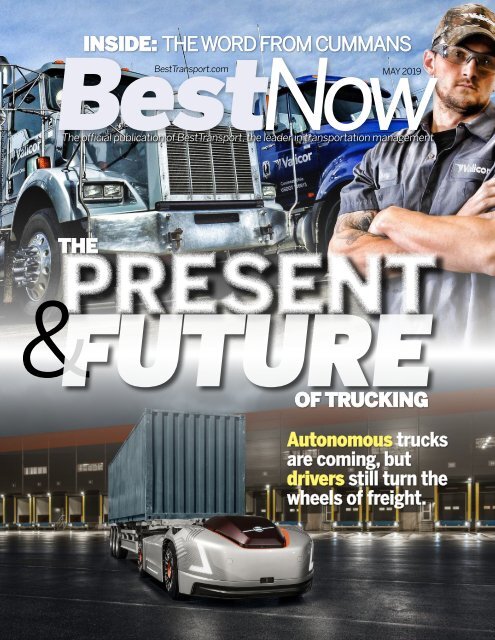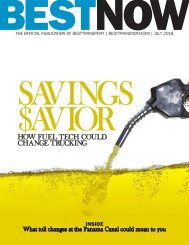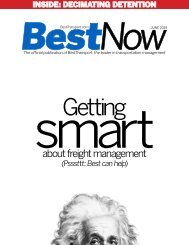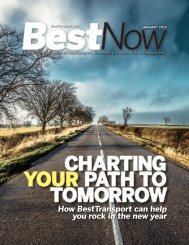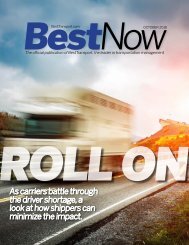BestNow
The latest from BestTransport, the leader in transportation management.
The latest from BestTransport, the leader in transportation management.
You also want an ePaper? Increase the reach of your titles
YUMPU automatically turns print PDFs into web optimized ePapers that Google loves.
INSIDE: THE WORD FROM CUMMANS<br />
<strong>BestNow</strong><br />
The official publication of BestTransport, the leader in transportation management<br />
BestTransport.com<br />
MAY 2019<br />
THE<br />
PRESENT<br />
&FUTURE<br />
OF TRUCKING<br />
Autonomous trucks<br />
are coming, but<br />
drivers still turn the<br />
wheels of freight.
PORT OF ENTRY THE WORD FROM SCOTT CUMMANS<br />
The value<br />
of a dime<br />
In our quest for continual improvement,<br />
we are proud to<br />
share some of our recent progress:<br />
UAT<br />
We will soon be moving our<br />
UAT computing environment to<br />
an offsite data center for improved<br />
reliability, availability and<br />
security.<br />
It will be in a secure data center<br />
with redundant power, faster<br />
communication speeds and<br />
advanced protection from fire<br />
and environmental disasters.<br />
Truckload visibility<br />
This has debuted with one client.<br />
This functionality provides<br />
real-time track and trace for<br />
truckloads.<br />
LTL rating<br />
We now offer LTL rating<br />
services (in lieu of SMC) which<br />
can result in accurate and timely<br />
rating at a reduced cost.<br />
Professional services<br />
In professional services, we<br />
have been focused on the LTL<br />
business processes. We are<br />
uniquely qualified to analyze<br />
freight spending and manage<br />
2 best now<br />
costs. With more than 40 years<br />
of transportation expertise, we<br />
can quickly pinpoint savings opportunities.<br />
Have you ever been driving<br />
down the highway deep<br />
in thought and looked down<br />
at your speedometer to see<br />
you are going 20 mph over the<br />
speed limit? Once realized you<br />
take immediate action and slow<br />
down.<br />
You may breathe a deep sigh<br />
CLICK HERE OR ON HIS NAME TO EMAIL SCOTT CUMMANS<br />
of relief that you didn’t get<br />
pulled over as a ticket for going<br />
90 mph in a 70 mph zone is<br />
costly. Worse, it could be deadly.<br />
Good cents<br />
A similar thing happens with<br />
LTL rates and tariffs. We get<br />
focused on managing the rest<br />
of the business and we take<br />
our eye off the rates and tariffs<br />
as they slowly eat away at our<br />
profits.<br />
Maybe it is only a 10-cent<br />
increase here and there.<br />
A dime does not sound like a<br />
lot. It is only 10 pennies. Or is it?<br />
Say a piece of freight is moving<br />
500 miles and the freight<br />
rate is increased from $2 to<br />
$2.10 per mile.<br />
Now $1,000 becomes $1,050,<br />
or a 5% increase. Fifty dollars<br />
doesn’t seem like much in the<br />
grand scheme of things. But<br />
let’s look at the impact this can<br />
have.<br />
Shipping 100 loads per day<br />
over 220 shipping days in a year<br />
results in significant financial<br />
impact. One-hundred loads per<br />
day times 500 miles times 10<br />
cents per mile times 220 days<br />
equals $1.1 million in additional<br />
freight costs.<br />
Just like speeding down the<br />
highway, the additional costs<br />
frequently go unnoticed until<br />
it is too late.<br />
Instead of a police officer<br />
asking why you were going so<br />
fast, it is your boss wondering<br />
why you haven’t been properly<br />
managing freight spending.<br />
What we have seen over<br />
the past few years are price<br />
increases well in excess of 10<br />
cents per mile.<br />
What we do and can do for<br />
our clients is help them not<br />
only monitor these increases<br />
but manage them.<br />
Consider, for example,<br />
changes to the LTL rules<br />
tariffs. Many of us pay no<br />
attention to the changes and<br />
before long costs have increased<br />
and we wonder what<br />
happened.<br />
Some LTL carriers hope the<br />
small increases go unnoticed<br />
so they enjoy increased revenue<br />
at the shipper’s expense.<br />
Reach out to us and we will<br />
be happy to engage with you<br />
and your specific circumstances.<br />
For you, our client, we always<br />
try to do the right thing.<br />
We don’t always do things<br />
right but we always go to<br />
great lengths to make things<br />
right.<br />
I always welcome any and<br />
all feedback as to how we are<br />
doing.<br />
Check it out<br />
Email PSG@BestTransport<br />
BestTransport’s<br />
Professional Services<br />
Group for help managing<br />
to better financial<br />
outcomes.<br />
The long american saga on<br />
infrastructure continues,<br />
just as it appeared some<br />
progress was being made.<br />
That sobering conclusion was<br />
offered recently by none other<br />
than Roger F. Wicker, who, as<br />
chairman of the Senate Commerce<br />
Committee, ought to know.<br />
“This will take time,” the Mississippi<br />
Republican said during<br />
the U.S. Chamber of Commerce’s<br />
recent Infrastructure Week advocacy<br />
forum. “If we do something<br />
really, really big, we need<br />
to realistically have a pay-for that<br />
works.”<br />
Finding one, or at least finding<br />
consensus on one, has been difficult.<br />
Congressional transportation<br />
officials faltered in recent<br />
efforts to reach a deal on an infrastructure<br />
package valued at $2<br />
trillion.<br />
OPEN TOP<br />
Sen. Roger Wicker on infrastructure package: “This will take time.”<br />
Fixes waiting<br />
game still on<br />
Congress continues to grapple with how<br />
to fund needed infrastructure upgrades<br />
Meanwhile, the U.S. Department<br />
of Transportation is pursuing<br />
a P3 option to kick-start local<br />
projects.<br />
“The federal government owns<br />
about 10% of our country’s infrastructure,<br />
and we fund currently<br />
about 14% of total infrastructure<br />
funding,” Dan DeBono, U.S.<br />
DOT’s chief infrastructure funding<br />
officer, said during a two-day<br />
summit. “We’d like to see that<br />
ratio shift back more to the states<br />
and localities. We think that giving<br />
the decision-making power<br />
back to local communities makes<br />
a lot of sense.”<br />
BestTransport Chief Operating<br />
Executive Reo B. Hatfield<br />
said simply, “Something must be<br />
done. We need tip-top roads to<br />
continue to drive commerce in<br />
this country. This has been left go<br />
for far too long.”<br />
may 2019 3
MAIN FRAME<br />
Over<br />
drivers<br />
Autonomous<br />
trucks’ day is<br />
on the verge of<br />
dawning, but<br />
drivers still are<br />
badly needed<br />
to keep freight<br />
moving.<br />
DB Schenker’s T-pod, a driverless truck manufactured by Einride, makes its way past idle trucks in Sweden.<br />
History began unfolding this<br />
month on a public road in southern<br />
Sweden, but the future, like heaven,<br />
can wait.<br />
A 23-foot electric cargo vehicle is<br />
rumbling on daily runs to and from<br />
a terminal and warehouse operated<br />
by German logistics giant DB Schenker. The track<br />
covers 300 meters, or slightly more than 2.4 times<br />
the expanse from home plate to the centerfield fence<br />
inside Yankee Stadium.<br />
Of course, the distance is not what everyone notices.<br />
It’s the driver. Or the lack of one. Nor any accommodations<br />
for one. The “T-pod,” as the equipment is<br />
called, features no cab but rather a chasis equipped<br />
with sensors and computers that allow the vehicle<br />
to drive itself. Beneath the trailer, a battery carries<br />
300 kilowatt hours of acapacity, enough carry it for<br />
120 miles. Its maximum permitted speed initially is<br />
roughly 3 mph and it is traveling just six miles a day.<br />
Robert Falck, CEO of Einride, the Stockholmbased<br />
manufacturer of the T-pod, calls the one-year<br />
commercial deal with Schenker “a first step.”<br />
Schenker CEO Jochen Thewes sees more steps on<br />
the horizon.<br />
“Autonomous trucks will become increasingly<br />
important for the logistics sector,” Thewes said in<br />
Continued on next page<br />
4 best now<br />
may 2019 5
A rendering of Volvo’s driverless rig backed into a dock.<br />
a statement. “Together with Einride,<br />
we have now introduced<br />
autonomous, fully electric trucks<br />
to a continuous flow on a public<br />
road — a milestone in the transition<br />
to the transport system of tomorrow.”<br />
Informed observers do not<br />
doubt Thewes’ assessment. After<br />
all, the allure of self-driving<br />
trucks is unmistakable. For starters,<br />
there is the latest driver<br />
shortage. Circumstances are not<br />
likely to improve given the fact<br />
that the average age of current<br />
drivers is roughly 55.<br />
Precisely how many heavy-duty<br />
truck drivers now are on the road<br />
is a subject of debate. The federal<br />
government pegs the number at<br />
1.8 million. The American Trucking<br />
Associations estimates nearly<br />
twice that at 3.5 million. Even<br />
based on the low number, the<br />
savings from phasing out drivers<br />
would be enormous at an estimated<br />
$70 billion annually. Fuel<br />
efficiency would rise. Productivity<br />
also would soar, by some 30%,<br />
since driverless trucks can run<br />
24/7 round the clock. Hours of<br />
service rules designed to eliminate<br />
accidents caused by fatigue<br />
limit drivers’ time on the road.<br />
But obstacles to the advent of<br />
the driverless era abound.<br />
First, the technology for mass<br />
production of autonomous trucks<br />
is not ready for prime time.<br />
In the case of Einride’s T-pod,<br />
the vehicle is closely monitored<br />
and can be guided from a control<br />
room in Borås, and someone<br />
is always physically nearby the<br />
truck, ready to take over if needed.<br />
Anheuser-Busch’s celebrated<br />
driverless truck, which famously<br />
delivered 51,744 beer cans in October<br />
2016, was escorted by four<br />
Colorado state patrol cruisers and<br />
three other vehicles with the Otto<br />
rig’s path cleared in advance by<br />
two tow trucks. Tests are tightly<br />
controlled. And autonomous<br />
trucks still aren’t prepped for the<br />
wide range of real-world situations<br />
they might face.<br />
Then there are the legal concerns.<br />
Who gets sued if a self-driving<br />
truck is involved in a fatal crash<br />
with a passenger vehicle? There<br />
are some 3,000 of those types<br />
of crashes each year, roughly 80<br />
percent the fault of the driver of<br />
the passenger vehicle. The legal<br />
framework now is nonexistent.<br />
Other issues exist.<br />
“The point,” says Reo B. Hatfield,<br />
BestTransport’s chief operating<br />
executive, “is that we still<br />
need drivers, and we are going to<br />
need them for a long time yet to<br />
come. So we need to take care of<br />
them.”<br />
6 best now<br />
J. Scott Cummans<br />
President and CEO<br />
Reo B. Hatfield<br />
chief operating executive<br />
1103 SCHROCK ROAD, SUITE 100, Columbus, OH 43229 | (614) 888-2378 | BestTransport.com


